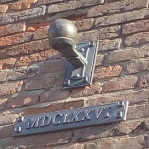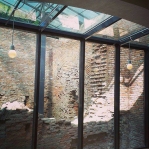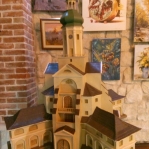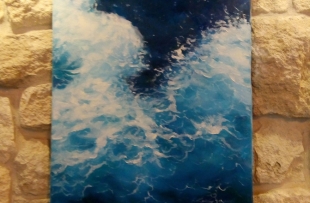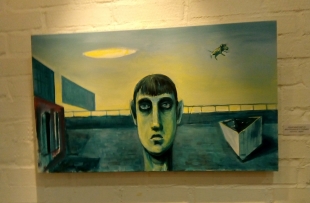The 6 most important Bastion attractions
The Bastion gallery is a favorite place for shopping and leisure-time activities of many Ivano-Frankivsk city`s residents. We have often visitors from other cities and even countries. But, perhaps, not all of our guests know about the most important things of the gallery that are definitely worth seeing. If you would like to know more about them, this mini-guide is for you.
Emblem of the Stanisławòw city
Against the background of the wall with ancient city`s emblem, gallery guests are often photographed, different presentations and meetings with artists are held nearby. However, not everyone knows how ancient history this emblem has. In 1663, Polish King Jan Casimir issued the privilege which confirmed that the Magdeburg right was awarded to Stanisławòw and allowed the use of the city`s emblem. This emblem has been repeatedly changed in small details of its image. But its original appearance was exactly like this: on the red field you can see the fortress gate with three towers. The silver Pilawa Cross is placed against a blue background inside the gate, and the whole composition is on a green hill.
We can see the city`s emblem on ancient city seals. It is believed that the oldest seal of the Stanisławòw city dates from 1670. It had a Latin inscription: "Sigillum civitatas Stanislavoviensi". (seal of the Stanisławòw city). In the XVII century, the seal like this was used to approve various documents in the city magistrate.
Model of the city hall
Since 2014, you can see in the Bastion gallery a model of the second city hall, built in 1695. It had a cross-shaped plan, nine floors and a turret with a cupola. At the level of the fifth floor, there was a clock with four scale plates. On the second and third floors, the meetings of magistrate and court were held. The merchants rented the ground floor and opened their shops there. In the basements, there was a prison, where criminals and opryshky (local guerrillas) served their sentence. The city hall was badly damaged during the fire in 1868. Only the burnt framework was left. The sculptors Dmitry and Taras Pylyponyuk from Bohorodchany district made the model of this city hall and it became the first in the Miniature city project, initiated by Mr. Oleg Zaritsky. Now, it is discussed which model of the city`s building should be next in this project.
Outlines of the Stanisławòw fortress
On the square of the Bastion gallery, you can see the colored outline of city fortress, which dates from 1680s. The first version of the Stanisławòw fortress was hexagonal and embodied the idea of a “star-formed city". The Italian architect Vincenzo Skamozzi developed this system, and it was considered the most progressive in the fortification at that time. Сreator of the Stanisławòw fortress, architect François Corassini, used the principles of this system in his project. At the initiative of the city`s founder Andrzej Potocki, during 1679-1682, the fortress was enlarged. The magnate residence was built and protected by two new bastions. The French architect Charles Benoit was busy with building the castle and enlarging the fortress. Illuminated contours of the city fortress are also shown on the stand inside the gallery.
Windows overlooking the casemates
Visiting the Milk & Pink Café, the gallery's guests not merely drink the delicious coffee, enjoy refined desserts, but also can see the remains of fortress casemates. These casemates were located inside the fortress along the inner walls and used as storage for ammunition and various reserves. From above, they were covered with a thick soil layer. It is interesting that the bricks were made by hand, smoothed from above with fingers that is why they are called "Gothic bricks with a frog made with fingers”. At the top of every brick, there are always several grooves made by fingers. The handicraft worker filled the wooden form with clay, then smoothed this clay with his fingers over the top and cleaned it. There were different grooves each time, so it is impossible to find two identical bricks like this.
Authentic stone masonry
On both sides from entrance on the Huzar-street, we can see two "windows" in the brick facing. They are intended for everyone to know what the ancient masonry looked like. The walls of the fortress were built of white, rough limestone. The history of limestone construction dates back more than a millennium, for example, Egyptian pyramids were built of limestone blocks. The most of medieval castles in Europe also consist of limestone, as it was easy to mine and to process. Even then, this building material was considered healthy, because it "breathed", and therefore the buildings did not have mold and too much humidity. It is believed that the stone walls of the fortress were first laid with brick in the 1690s.
Ancient cannonball
To the right of the entrance on the Huzar-street, there is another interesting thing, the ancient cannonball. Ivan Bondarev, the local historian, found it and presented to the gallery. The cannonball is fixed on a metal bracket, and below there is a plaque with symbols "MDCLXXVI", i.e. "1676" in Roman numerals. There is an assumption that this little souvenir dates from the time of the first battle on the Stanisławòw Fortress in 1676. It was the siege by Turkish troops headed by Ibrahim Pasha, nicknamed Shaitan. The Turkish army of many thousands soldiers stayed near Stanisławòw for several weeks, but could not get the city. Disappointed Turks moved northwards and occasionally burned down the Halych city. It is interesting that the caliber of cannon was determined by the weight of cannonball at that time. The weight was calculated in pounds and the Polish pound made up 405 grams. Large-caliber weapons were 12- and 8-pound cannons, but there were also some smaller cannons at three or one and a half pounds.
03.10.2023



